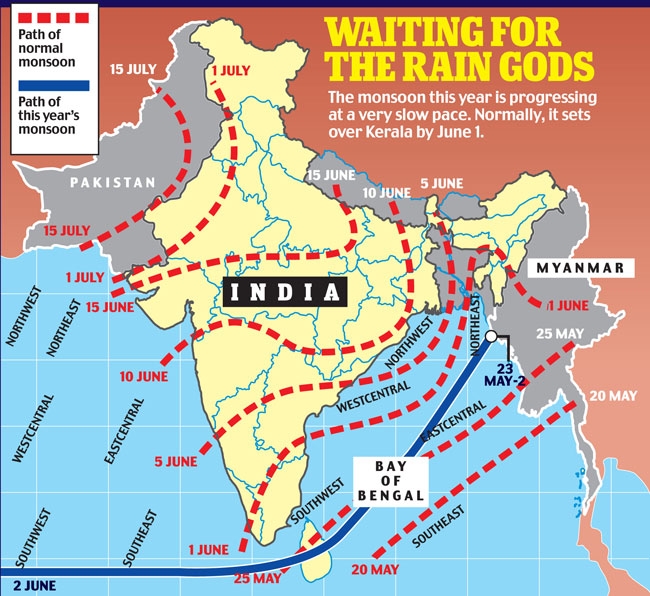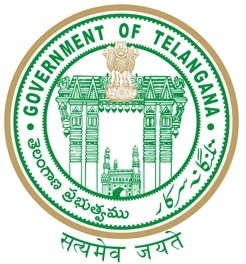Monsoon arrives in Kerala
After a week-long wait, the South West Monsoon arrived in Kerala on Friday bringing widespread rains in most parts of the state. It was late by six days.
In 2014, India is likely to have below-average monsoon rainfall.

After a week-long wait, the South West Monsoon arrived in Kerala on Friday bringing widespread rains in most parts of the state. It was late by six days.
In 2014, India is likely to have below-average monsoon rainfall.

_0_o.jpg)
 Telangana, India's newest and the 29th state is born (02 June 2014). Kalavakuntla Chandrasekhar Rao (KCR) has taken oath as the first Chief Minister of Telangana on 02 June 2014.
Telangana, India's newest and the 29th state is born (02 June 2014). Kalavakuntla Chandrasekhar Rao (KCR) has taken oath as the first Chief Minister of Telangana on 02 June 2014.
Nara Chandrababu Naidu will swear-in as the first Chief Minister of Seemandhra or residual Andhra Pradesh on 08 June 2014.
Hyderabad will serve as a joint capital for both Telangana and Andhra Pradesh for 10 years.
 copy_2_o.jpg)
Very Short Answer Questions
Q1. What is a resource?
Ans: Anything that can be used to satisfy human needs is a resource. E.g. wind, water, flora, fauna, etc.
OR
All the objects in the environment which are useful to man and have value can be termed as a resource.
Q2. What is sustainable development?
Ans: Balancing the need to use resources and also conserve them for the future is called sustainable development.
Long Answer Questions
Q3. Write a note on the classification of resources.
Ans: Classification of Resources:

Natural Resources:
1. On the basis of Origin of Resources:
(a) Biotic (b) Abiotic
(a) Biotic Resource: All living things are known as Biotic Resources. These resources are obtained from the Biosphere and they have life, such as – Human Beings, Flora, Fauna, fisheries, etc.
(b) Abiotic Resource: All non-living things are known as Abiotic Resources, such as Wind, Water, Air, Rocks, Metals, etc.
2. On the basis of Exhaustibility or Utility of Resources:
(a) Renewable (b) Non-Renewable
(a) Renewable Resource: Resources which can be renewed or reproduced are known as Renewable Resource. E.g. Solar & Wind energy, Water, etc. Resources like Wind, Sunlight, are present in such huge quantities that human consumption does not effect them.
Many resources are replenishable which means these resources are recycled within the environment by natural process and their quantities remain constant. E.g. Oxygen Cycle and Water Cycle take place rapidly, whereas e.g. like Rock Cycle is very slow.
(b) Non-Renewable Resource: Resources get exhausted when used. These resources cannot be renewed or reproduced. Fossil Fuels like, coal, petroleum, natural gas are the best examples of non-renewable resource. These resources are limited in supply and it takes millions of years in their formation.
Metals like Gold, Silver, Copper and Iron are recyclable.
3. On the basis of Stage of Development of Resources:
(a) Actual Resource (b) Potential Resource
(a) Actual Resource: Resources whose existence has been proved and whose quality, quantity and location has been determined for utilization with the available technology. E.g. Assam oil fields, Damodar coal fields, etc.
(b) Potential Resource: Resources which are found in a region but have not been utilized, might be because of the lack of technology. They can be used in future. E.g. Solar and Wind are potential resource. Rajasthan and Gujarat have great potential for the development of these two resources.
Largest Solar Plant in India - Madhapur, Bhuj (Kutch, Gujarat)
Largest Wind farm cluster in India – Nagercoil (Tamil Nadu)
4. On the basis of Distribution of Resources:
(a) Ubiquitous (b) Localised
(a) Ubiquitous Resource: Resources which are found everywhere are called ubiquitous resource. E.g. air, land, water, etc.
(b) Localised Resource: Resources which are found only in certain places are localised resources, like coal, petrol, iron, etc.
5. On the basis of Ownership of Resources:
(a) Individual (b) Community (c) National (d) International
(a) Individual Resource: Resources which are owned by an individual. E.g. plot, car, house, etc.
(b) Community Resource: Resources which belongs to a community of people. E.g. parks, community halls, picnic spots, etc.
(c) National Resource: Resources which belongs to a nation. These resources are found within the political boundaries and territorial waters of a country. E.g. rivers, forests, minerals, etc.
(d) International Resource: Resources which are found beyond the territorial boundaries of a country. These resources are managed by the international institutes. No single country can use these resources without the permission of the international authorities. E.g. Minerals, fisheries, etc.
Human Resources:
Human Made Resources:
Q4. Explain the different ways of conservation of forests and wildlife.
Ans: Following are the different ways of conservation of forests and wildlife:
(a) Controlling deforestation.
(b) Planting more-and-more trees (Aforestation).
(c) Not disturbing animal habitats.
(d) Hunting should be banned and strict punishment should be given to those who violate this.
(e) More number of bioreserves, national parks and wild life centuries should be made so that we can protect the endangered species of our flora and fauna.
(f) Unfair animal trading should be stopped. Heavy penalties should be imposed on offenders.
(g) Proper education and awareness should be spread amongst the people.
(h) Proper government policies should be made for the protection of forests and wildlife.
(i) More NGO's (Non Government Organizations) should come forward for the protection.
(j) Celebration of Van Mahotsav. Every National festival is followed by tree plantation ceremony.
Q5. Explain the need of conservation of resources and mention a few steps to conserve resources.
Ans: Using resources carefully, judicially and giving them time to get renewed is called resource conservation. It is very necessary to use the resources very carefully as they are part of our life support system. With the rapid growth of population, urbanization and industrialization there has been an increased demand and consumption of resources. This has led to the overexploitation and depletion of resources. To prevent misuse, overexploitation and depletion, the conservation of resources is necessary and it's the need of the hour. Following are the few steps to conserve resources: -
(a) Recycle everything you can; newspaper, cans, glass, aluminum foil and pans, motor oil, scrap metal, etc.
(b) Don't use electrical appliances for things you can easily do by hand.
(c) Don't leave water running needlessly.
(d) Plant shrubs and trees that provide food and shelter for birds and other creatures.
(e) Proper usage of the resources without wasting.
(f) Using alternative sources of energy wherever possible like wind energy etc.
(g) Proper planning before use of materials.
(h) By creating awareness amongst the people.
Q6. List of four principles of sustainable development.
Ans:
Q7. Human resource is the most valuable resource of the present time. Elaborate.
Ans: Human resource consists of people. Human resource and its proper development are of great importance. The creative mind of humans and the desire to satisfy their need helped them to produce different products and services that we see, feel and observe in our day-to-day life. For example: iron ore was used to build tools, machines, etc.
People with healthy mind and body have great potential to produce anything that they desire. People can make the best use of nature to create more resources when they have the knowledge, skill and the technology to do so. That is why human beings are a special resource and they are the most valuable resource of the present time.
-----x-----X-----x-----
Project Topic : OUR ENVIRONMENT
Software Used : MS POWERPOINT
Important: Project should be prepared only on the basis of the educational field trip which was organized on 27 April 2014 (Sunday).
GUIDELINES (SOCIAL SCIENCE - GEOGRAPHY):
1. Students will highlight all the details related to the environment which they have seen, noticed, observed, felt during the educational field trip organized on 27 Apr 2014.
2. Student needs to explain role of human beings in the construction or destruction of the environment.
3. Add photographs to your presentation to highlight the important phases of the trip.
GUIDELINES (ENGLISH):
1. Presentation, delivering and briefing the topic as per the slides.
2. Uses of language and Sentence Formation.
3. Overall content.
GUIDELINES (COMPUTER SCIENCE):
1. Students will prepare a documentation of minimum of 15 slides.
2. Document must be formatted using various formatting options.
3. Animation effects should be given to all the slides.
4. Proper clip art, word art and all formatting should be done.
5. Use of Auto shapes i.e., Banners, Call outs, etc. should be made to make to make presentation attractive.
6. Rehearse Timings should be given to the presentation.
7. You can also give Sound (Audio) and Video files to your presentation.
8. Flow charts can be projected to explain sequence if needed.
9. The Presentation should be typed using proper Case as needed and should summarize the entire plan of trip.
-----x-----X-----x-----
 27 apr 2014 (copy)_1_o.jpg)
 27 apr 2014 (copy)_1_o.jpg)